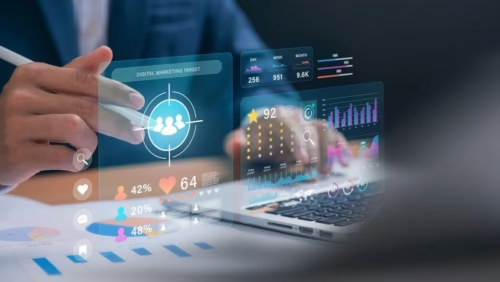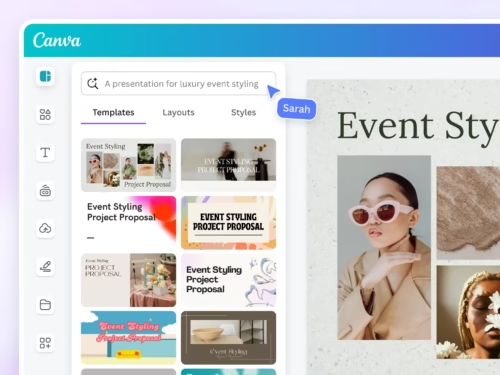The question is simple, the choices are not. Teams want the best AI tool for digital marketing that fits goals, data, and budget. This guide comes from hands-on stacks for SMB and mid-market teams. It gives a quick verdict, a simple framework, category winners, a plain text comparison, and a 30-60-90 day plan.
Expect clear trade-offs and realistic outcomes. Human-in-the-loop stays in every workflow for accuracy, brand safety, and compliance. By the end, you can select one pilot, set KPIs, and move with confidence. This is a practical map, not hype. The focus is on ROI and AI marketing automation that earns its keep.
Quick verdict: the best AI tool for digital marketing in 2026 by use case
- Best overall AI marketing automation (SMB to mid-market): HubSpot AI. Balanced CRM, email marketing AI, customer segmentation, and predictive analytics add-ons. Brevo is the budget pick.
- Best content generation AI for blogs, SEO, and ads: Jasper + Surfer SEO. Strong briefs, tone control, internal link prompts, and support for voice search optimization.
- Best ad campaign optimization: Optmyzr or Madgicx. Strong budget pacing, anomaly detection, and creative testing across Google and Meta.
- Best personalization engines for on-site and in-app: Mutiny for B2B, Dynamic Yield for commerce. Helps conversion rate optimization at scale.
- Best chatbots and virtual assistants for support and sales: Intercom for SMB to mid-market, Drift for sales-heavy teams.
- Best social media analytics and scheduling: Sprout Social, with Hootsuite as a lower-cost alternative.
- Best email marketing AI and lifecycle for ecommerce: Klaviyo. Mailchimp AI as a starter.
- Best predictive analytics for scoring and churn: Salesforce Einstein, Adobe Analytics AI as a lighter option.
- Best visual content creation: Canva with Magic Design, Adobe Express or Firefly for advanced teams.
Start where the constraint is. Pick one AI marketing automation tool or email marketing AI if lifecycle drives revenue. Use content generation AI if production is the bottleneck. Shift to ad campaign optimization if paid media spend is rising and performance is uneven.
Photo by Matheus Bertelli
Who this guide is for
Digital marketing managers at SMBs, solo founders, content marketers, SEO specialists, performance marketers, social media managers, ecommerce marketers, and agencies. Mid-market teams with compliance needs will find SSO and SOC 2 notes in each section. The tone is practical, focused on outcomes and trade-offs, with examples drawn from real stacks.
What we measured and why it matters
Tools are judged on CTR, CVR, CPA, revenue per send, lift in conversion rate optimization, and time saved per task. We value data-driven decision making, predictive analytics, customer segmentation, and market trend forecasting where volume supports it.
Results improve with clean data, stable traffic, and tight QA. A human-in-the-loop is required for accuracy, brand safety, and compliance in regulated niches.
How to choose your AI marketing stack in 2026: a simple 5-part framework
Start with the outcome, not the feature list. Tie each tool to one clear goal. Map the minimum data needed. Assign an owner. Then run a four-week test against a manual baseline. Use simple prompts, clear guardrails, and auditor-friendly logs.
- Match tools to channel goals. If acquisition is weak, consider ad campaign optimization and content generation AI. If retention is flat, use email marketing AI and personalization engines.
- Confirm data access. CRM and GA4 are the backbone. Product feeds, ad accounts, and support tickets add needed context.
- Plan for team capacity. Keep the first workflow small. Set QA and approvals.
- Manage risk and compliance. Respect consent, retention, and opt-outs.
- Price the true cost. Seats, contacts, sends, credits, and ad spend tiers drive the bill.
Build in monthly reviews. Keep prompts, naming, and reports standard. Document what works and roll it to the next channel.
1) Set goals by channel, not features
Tie each tool to acquisition, retention, conversion rate optimization, or production speed. Map common workflows: email journeys, ad campaign optimization, content calendars, on-site personalization, chatbots and virtual assistants, and social media analytics. Reduce the scope to the smallest workflow you can automate first. Ship one quality pilot before scaling.
2) Map your data access and quality
List core sources: CRM, GA4, product catalog, ad accounts, call tracking, and support tickets. Better data enables predictive analytics, customer segmentation, and personalization engines that work. Confirm consent, UTM hygiene, and event tracking. If a tool needs a product feed or a CDP, plan that dependency early. Poor inputs stall results.
3) Team capacity and workflow fit
Assign owners for setup, prompts, QA, and reporting. Roles include marketing ops, content lead, lifecycle manager, media buyer, and support lead. Needed skills: prompting, QA checklists, data basics, and brand voice controls. Keep workflows simple and measurable in the first test.
4) Risk, compliance, and governance
Check GDPR and CCPA posture, retention windows, SSO, and SOC 2 options. Opt out of model training on customer data where possible. Watch PII in chatbots and virtual assistants and email marketing AI. Require approval flows, version history, and audit logs to protect the brand.
5) Budget model and true cost
Understand pricing drivers: seats, contacts, sends, usage credits, API calls, and ad spend tiers. Hidden costs include add-on predictive analytics, personalization modules, and social listening. Run a four-week test with a manual baseline before any annual commitment. Track the lift, or pause.
Best AI tools by category in 2026: winners, pricing, and real outcomes
For a broader context on where AI marketing tooling is heading in 2026, this overview of the best AI marketing tools for 2026 provides a useful cross-section of categories and use cases.
All-in-one AI marketing automation: HubSpot AI
Best for SMB to mid-market teams that want CRM, email marketing AI, AI marketing automation, and customer segmentation in one place. Key AI includes a content assistant for emails and pages, send-time optimization, predictive analytics for lead scoring, and basic chatbots and virtual assistants. Pricing starts low and scales with contacts and seats, with predictive features in higher tiers. Integrations cover Salesforce, Shopify, Google Ads, GA4, forms, and calendars.
Setup takes 2 to 4 weeks and is owned by marketing ops with a content owner. Benchmarks: 10 to 20 percent open rate lift from timing AI, 5 to 12 percent better CVR with improved scoring and nurture, and major time saved in campaign build. Compliance includes GDPR tools, consent tracking, and SSO on higher plans.
Review model training settings for content tools. Pros include a strong suite and a clean UI. Cons include rising costs at scale and some rigid workflows. Who should not use this: teams that need deep BI, heavy custom data models, or on-prem.
Email marketing AI and lifecycle: Klaviyo (Mailchimp AI)
Best for ecommerce brands that need email marketing AI, SMS, recommendations, and personalization engines tied to purchase data. Key AI includes predictive analytics for expected spend and churn, product feed recommendations, send-time optimization, and subject line testing.
Pricing scales with contacts and SMS volume. Mailchimp AI is cheaper to start but lighter in advanced features. Integrations include Shopify, BigCommerce, Woo, Meta, and GA4.
Setup is 1 to 2 weeks for core flows, owned by a lifecycle manager. Benchmarks: 5 to 15 percent revenue lift from recommendations, and 2 to 5 points CTR gain through better segmentation and timing, with results dependent on list health and offer.
Compliance includes GDPR preference management, opt-out tools, and data exports. Review retention settings. Pros include deep ecommerce data. Cons include rising costs as lists grow and careful SMS compliance needs. Who should not use this: low-volume senders without a product feed. For more options and trends, see this review of top AI-powered email marketing tools for 2026.
Content generation AI for blogs, SEO, and ads: Jasper + Surfer SEO
Best for teams that need fast briefs, outlines, and on-brand drafts. Strong for voice search optimization and data-driven decision making. Key AI includes content generation AI for articles, ads, and emails, brand voice controls, outline and brief builders, and NLP optimization plus internal link prompts via Surfer. Pricing is seat-based with usage caps, and Surfer is billed separately. Integrations include Google Docs, CMS plugins, and Grammarly.
Setup is same day, with 1 to 2 days invested in style guides and prompt libraries. Benchmarks: 30 to 50 percent faster production. Rankings improve when paired with quality links and solid E-E-A-T. Compliance requires turning off model training where needed and running plagiarism checks. Pros include speed and consistency. Cons include the need for a human editor and the risk of over-optimization. Who should not use this: teams with strict legal review that requires fully manual drafting. For broader tool lists, this roundup of best AI tools for 2026 is useful background.
SEE ALSO: Best AI Tools to Create Viral Shorts in 2026 (Workflows, Stacks, and Real Results)
Social media analytics and scheduling with AI: Sprout Social ( Hootsuite)
Best for social teams that want social media analytics, smart scheduling, and sentiment analysis tools. Key AI includes optimal posting times, content suggestions, sentiment analysis, and competitor benchmarking. Pricing is per seat, with listening and advanced analytics in higher tiers. Integrations cover Facebook, Instagram, TikTok, LinkedIn, and YouTube, with CRM exports.
Setup takes 1 to 3 days, owned by the social lead. Benchmarks: 10 to 25 percent engagement lift from better timing and content mix. Reporting time drops weekly. Compliance includes role-based access and audit logs. Confirm data retention and export. Pros include clean reporting. Cons include rising costs with many seats. Who should not use this: tiny teams that only need basic scheduling. For trend context, see the projected AI trends that will change marketing in 2026.
Ad campaign optimization across Google, Meta, and TikTok: Optmyzr or Madgicx
Best for performance marketers who want ad campaign optimization beyond native tools. Key AI includes budget pacing, anomaly detection, creative fatigue alerts, audience splits, and predictive analytics for bids. Pricing is based on ad spend or feature tiers. Integrations support Google, Meta, TikTok, and GA4.
Setup takes 3 to 7 days and is owned by the media buyer. Benchmarks: 10 to 25 percent CPA reduction with smarter budgets and creative rotation. These tools need enough conversion volume to learn. Compliance uses platform APIs, and consent is required for audience uploads. Pros include faster diagnosis and better pacing. Cons include less impact at low data volume. Who should not use this: accounts under about 5,000 dollars per month in ad spend.
Predictive analytics for lead scoring and churn: Salesforce Einstein (Adobe Analytics AI)
Best for teams with strong CRM hygiene that need scoring, next-best-action, and market trend forecasting. Key AI includes predictive analytics for lead score and churn, anomaly flags, and journey insights. Pricing is per user or add-on, with value tied to data completeness. Integrations are native to Salesforce, while Adobe works best in the Adobe stack.
Setup is 3 to 6 weeks, owned by marketing ops with a data partner. Benchmarks: 10 to 30 percent better MQL to SQL rates when scores drive routing and nurture. Compliance includes SOC 2 and GDPR/CCPA tooling, with controls over which data fields sync to models. Pros include deep insights and routing gains. Cons include setup time and the need for clean data. Who should not use this: teams without reliable CRM events.
Personalization engines for on-site and in-app: Mutiny or Dynamic Yield
Best for B2B (Mutiny) and commerce (Dynamic Yield) teams that want targeted experiences to drive conversion rate optimization. Key AI includes audience discovery, templates, recommendations, and personalization engines. Pricing is premium with annual contracts. Integrations require a tag manager, CDP or CRM, and a product feed for commerce.
Setup is 2 to 4 weeks and is owned by a growth or CRO lead. Benchmarks: 5 to 20 percent lift in demo or add-to-cart rates when traffic is steady and tests run long enough. Compliance includes role controls and consent checks. Document test exposure rules. Pros include a strong uplift. Cons include the need for traffic and test rigor. Who should not use this: sites with under 30,000 monthly sessions.
Chatbots and virtual assistants for support and sales: Intercom (enterprise Drift)
Best for faster responses, better routing, and lead capture with chatbots and virtual assistants on the web and in-app. Key AI includes answer suggestions, intent detection, and workflows tied to CRM and knowledge bases. Pricing is seat plus volume, with attention to resolution counts. Integrations include Salesforce, HubSpot, Shopify, Slack, and webhooks.
Setup is 1 to 2 weeks, owned by the support lead with sales ops. Benchmarks: 20 to 40 percent faster first response and 10 to 25 percent more qualified leads, depending on playbooks and traffic. Compliance includes GDPR tools, SSO, and data masking, with retention controls for chat transcripts. Pros include quick wins. Cons include the need for good conversation design and guardrails. Who should not use this: teams without a knowledge base or clear handoff rules. Practitioner threads, such as this discussion on what AI tools actually help marketers, surface similar value patterns.
Voice search optimization and AI SEO helpers: Jasper + Surfer, FAQ and schema tooling
Best for blogs and help centers focused on questions and voice search optimization. Key AI includes content generation AI for question clusters, schema prompts, and internal link maps. Pricing aligns with the content stack, with optional schema tools adding cost. Integrations include CMS schema plugins and analytics.
Setup is owned by the content or SEO lead. Benchmarks include more featured snippets and better long-tail CTR, shaped by intent match and page speed. Compliance means following search engine guidelines and documenting sources to reduce hallucination. Pros include faster briefs and outlines. Cons include the need for editor review. Who should not use this: sites without a content plan or link strategy.
Sentiment analysis tools for brand monitoring: Sprout Social Listening
Best for brands that need early alerts on PR risk and insights for social media analytics. Key AI includes sentiment analysis tools, trend clustering, and competitor mentions. Pricing rises in higher tiers with listening and exports. Integrations cover major social networks with export to BI.
Setup is 1 to 3 days, owned by the social or comms lead. Benchmarks: faster response to spikes and better crisis handling, with value growing as volume scales. Compliance includes role-based access and data retention settings, with clear terms for data use. Pros include strong insights. Cons include the cost for small teams. Who should not use this: brands with minimal social volume.
Visual content creation for ads and socials: Canva with Magic Design (Adobe Express/Firefly)
Best for fast ad variants, thumbnails, and social graphics using visual content creation. Key AI includes Magic Design, resize, brand kits, and AI image generation. Pricing is low per seat. Adobe Express or Firefly serves advanced teams. Integrations include cloud drives, CMS, and social schedulers.
Setup is same day, owned by content or design leads. Benchmarks: 2 to 4 times faster creative testing, with ad CTR improving through faster iteration. Compliance benefits from brand kits and approval flows. Check image licensing rules. Pros include speed and ease. Cons include limits for complex motion design. Who should not use this: teams that need heavy post-production or 3D.
Side-by-side comparison and a 30-60-90 day action plan
Plain text mini-table: top tools, price signals, and core use case
Category | Top Tool | Typical SMB Price | Cost Driver | Core Win
AI Marketing Automation | HubSpot AI | starts ~$50/mo | contacts, seats | faster launches
Content Generation AI | Jasper + Surfer | seat-based | seats, usage | speed, consistency
Ad Campaign Optimization | Optmyzr or Madgicx | tiered | ad spend | lower CPA
Email Marketing AI | Klaviyo | tiered | contacts, SMS | revenue per send
Personalization Engines | Mutiny or Dynamic Yield | premium | traffic | higher CVR
Chatbots and Virtual Assistants | Intercom | seat + volume | resolutions | faster replies
Social Media Analytics | Sprout Social | per seat | seats, listening | better engagement
Predictive Analytics | Salesforce Einstein | per user | users | better routing
Visual Content Creation | Canva | low per seat | seats | faster creative
Days 1–30: pick one workflow, define KPIs, set QA rules
Run a four-week pilot. Choose one workflow, such as welcome series, abandoned cart, or budget pacing. Connect the minimum data. Write prompt and approval rules. Set KPIs: CTR, CVR, CPA, revenue per send, and time saved. Add guardrails for tone, claims, and PII. Run a quick GDPR and CCPA risk check, including data retention. If the pilot is supported, include chatbots and virtual assistants with clear handoffs and masked data.
Days 31–60: integrate with CRM and analytics, run A/B tests
Expand to one full channel. Connect CRM, GA4, and ad accounts where relevant. Launch A/B tests with a human-in-the-loop. Use predictive analytics once there is enough volume. Apply customer segmentation for targeting and use personalization engines for on-site tests. Start social media analytics reporting to track reach, engagement, and sentiment analysis tools output.
Days 61–90: standardize prompts, document workflows, confirm ROI
Lock gains. Build prompt libraries, SOPs, and approval flows. Roll out to a second channel. Review ROI and risk monthly. Track outcomes in one sheet: CTR, CVR, CPA, revenue lift, and time saved. Plan hires or training if usage grows. Add voice search optimization and content generation AI if content is the bottleneck. Keep market trend forecasting in review cycles to adjust budgets and priority.
Conclusion
The quick verdict is simple. Start with one tool mapped to one outcome. The five-part framework, goals to budget, reduces risk, and lifts clarity. Match picks to goals, data, team skills, and budget. The best ai tool for digital marketing is the one that ships value in four weeks, not a year. Take one next step, pick a pilot, set KPIs, and review in 30 days. Keep a human-in-the-loop for accuracy and brand safety.



















